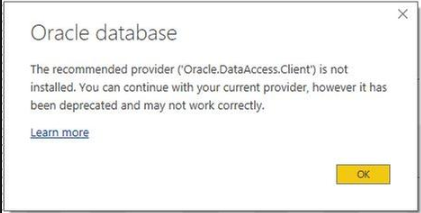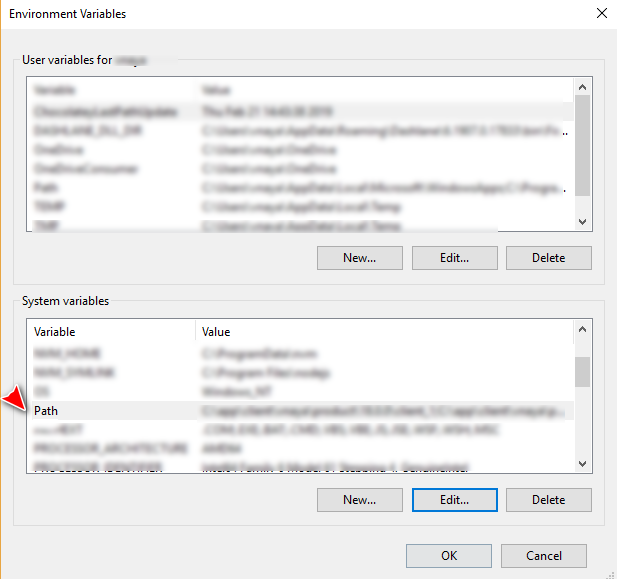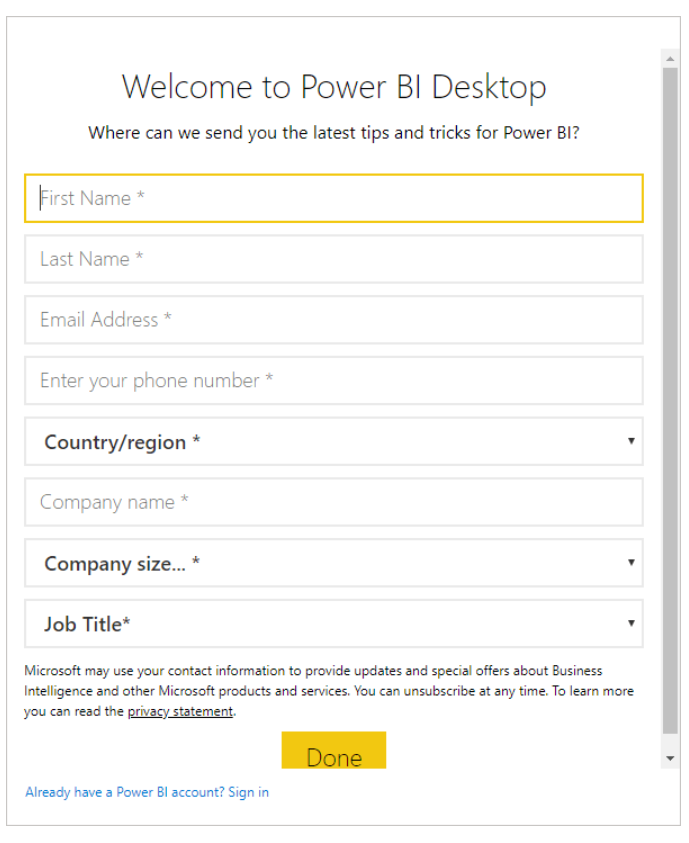It can run alongside the unmanaged Oracle Services for MTS version if unmanaged data access drivers, such as ODBC, are also using distributed transactions on the same machine. There are two versions of Oracle.ManagedDataAccessDTC.dll, one for 32-bit.NET Framework and one for 64-bit.NET Framework, installed with ODP.NET, Managed Driver. Power Query also provides you with the ability to search for public data from sources such as Wikipedia. 0 1 Question text/html 8:33:07 AM AhmedRehan 0. The managed provider 'Oracle.DataAccess.Client' could not be instantiated. Unable to find the requested.Net Framework Data Provider. It may not be installed. The database is accessable and I also have the appropriate grands since the option of 'import' works without any problems. Updated my Desktop and Gateway versions in Dec 2019, and have not been able to reconnect to Oracle since. I have had about a dozen troubleshooting sessions with support, without resolution. It is extremely frustrating.
- Power Bi Desktop Oracle.dataaccess.client Is Not Installed
- Power Bi Oracle.dataaccess.client Not Installed
- Oracle Dataaccess X64
- Power Bi Oracle Data Access Client Not Installed Windows
- Power Bi Oracle Data Access Client Not Installed Failed

Para conectarse a una base de datos de Oracle con Power BI Desktop, en el equipo donde se ejecute Power BI Desktop debe estar instalado el software cliente de Oracle correcto.To connect to an Oracle database with Power BI Desktop, the correct Oracle client software must be installed on the computer running Power BI Desktop.El software cliente de Oracle que use depende de la versión que Power BI Desktop que haya instalado: 32 bits o 64 bits.The Oracle client software you use depends on which version of Power BI Desktop you've installed: 32-bit or 64-bit.También depende de la versión del servidor de Oracle.It also depends on your version of Oracle server.
Versiones de Oracle compatibles:Supported Oracle versions:
- Oracle Server 9 y versiones posterioresOracle Server 9 and later
- Software de Oracle Data Access Client (ODAC) 11.2 y versiones posterioresOracle Data Access Client (ODAC) software 11.2 and later
Nota
Si va a configurar una base de datos de Oracle para Power BI Desktop, una puerta de enlace de datos local o Power BI Report Server, consulte la información del artículo Tipo de conexión de Oracle.If you're configuring an Oracle database for Power BI Desktop, On Premises Data Gateway or Power BI Report Server, consult the information in the Oracle Connection Type article.
Determinación de versión instalada de Power BI DesktopDetermining which version of Power BI Desktop is installed
Para determinar la versión de Power BI Desktop instalada, seleccione Archivo > Ayuda > Acerca de y, luego, revise la línea Versión.To determine which version of Power BI Desktop is installed, select File > Help > About, then check the Version line.En la siguiente imagen, hay instalada una versión de 64 bits de Power BI Desktop:In the following image, a 64-bit version of Power BI Desktop is installed:
Instalación del cliente de OracleInstall the Oracle client
Para la versión de 32 bits de Power BI Desktop, descargue e instale el cliente de Oracle de 32 bits.For the 32-bit version of Power BI Desktop, download and install the 32-bit Oracle client.
Para la versión de 64 bits de Power BI Desktop, descargue e instale el cliente de Oracle de 64 bits.For the 64-bit version of Power BI Desktop, download and install the 64-bit Oracle client.
Nota
Elija una versión de Oracle Data Access Client (ODAC) que sea compatible con el servidor de Oracle.Choose a version of Oracle Data Access Client (ODAC) which is compatible with your Oracle Server.Por ejemplo, ODAC 12.x no siempre es compatible con la versión 9 de Oracle Server.For instance, ODAC 12.x does not always support Oracle Server version 9.Elija el instalador de Windows del cliente de Oracle.Choose the Windows installer of the Oracle Client.Durante la configuración del cliente de Oracle, asegúrese de habilitar Configurar los proveedores de ODP.NET y/o Oracle para ASP.NET en el nivel de equipo mediante la casilla correspondiente en el asistente para la instalación.During the setup of the Oracle client, make sure you enable Configure ODP.NET and/or Oracle Providers for ASP.NET at machine-wide level by selecting the corresponding checkbox during the setup wizard.Algunas versiones del asistente para clientes de Oracle activan la casilla de forma predeterminada y otras no.Some versions of the Oracle client wizard selects the checkbox by default, others do not.Asegúrese de que la casilla está activada para que Power BI pueda conectarse a la base de datos de Oracle.Make sure that checkbox is selected so that Power BI can connect to your Oracle database.
Conectarse a una base de datos de OracleConnect to an Oracle database
Después de instalar el controlador cliente de Oracle que corresponda, puede conectarse a una base de datos de Oracle.After you install the matching Oracle client driver, you can connect to an Oracle database.Siga estos pasos para establecer la conexión:To make the connection, take the following steps:
Desde la pestaña Inicio, seleccione Obtener datos.From the Home tab, select Get Data.
En la ventana Obtener datos que aparece, seleccione Más (si es necesario), seleccione Base de datos > Base de datos de Oracle y después Conectar.From the Get Data window that appears, select More (if necessary), select Database > Oracle database, and then select Connect.
En el cuadro de diálogo Base de datos de Oracle que aparece, proporcione el nombre del servidor y seleccione Aceptar.In the Oracle database dialog that appears, provide the name of the Server, and select OK.Si se requiere un SID, especifíquelo con el formato siguiente: NombreDeServidor/SID, donde SID es el nombre único de la base de datos.If a SID is required, specify it by using the format: ServerName/SID, where SID is the unique name of the database.Si el formato NombreDeServidor/SID no funciona, use NombreDeServidor/NombreDeServicio, donde NombreDeServicio es el alias que se usa para conectarse.If the ServerName/SID format doesn't work, use ServerName/ServiceName, where ServiceName is the alias you use to connect.
Nota
Si está utilizando una base de datos local, o conexiones a bases de datos autónomas, es posible que deba colocar el nombre del servidor entre comillas para evitar errores de conexión.If you are using a local database, or autonomous database connections, you may need to place the server name in quotation marks to avoid connection errors.
Si quiere importar datos con una consulta de base de datos nativa, incluya la consulta en el cuadro Instrucción SQL, que aparece al expandir la sección Opciones avanzadas del cuadro de diálogo Base de datos de Oracle.If you want to import data by using a native database query, put your query in the SQL statement box, which appears when you expand the Advanced options section of the Oracle database dialog.
Una vez que haya escrito la información de la base de datos de Oracle en el cuadro de diálogo Base de datos de Oracle (incluida toda información opcional, como un SID o una consulta de base de datos nativa), seleccione Aceptar para conectarse.After you've entered your Oracle database information in the Oracle database dialog (including any optional information such as a SID or a native database query), select OK to connect.
Si la base de datos de Oracle necesita credenciales del usuario de la base de datos, ingréselas en el cuadro de diálogo cuando se le solicite hacerlo.If the Oracle database requires database user credentials, input those credentials in the dialog when prompted.
Solución de problemasTroubleshooting
Es posible que se produzcan varios errores en Oracle si la sintaxis de los nombres no es correcta o no está configurada correctamente:You might encounter any of several errors from Oracle when the naming syntax is either incorrect or not configured properly:

- ORA-12154: TNS:no se ha podido resolver el identificador de conexión especificado.ORA-12154: TNS:could not resolve the connect identifier specified.
- ORA-12514: TNS:el listener no conoce actualmente el servicio solicitado en el descriptor de conexión.ORA-12514: TNS:listener does not currently know of service requested in connect descriptor.
- ORA-12541: TNS:no hay ningún listener.ORA-12541: TNS:no listener.
- ORA-12170: TNS:error de tiempo de espera de conexión.ORA-12170: TNS:connect timeout occurred.
- ORA-12504: TNS:el listener no ha recibido el SERVICE_NAME en CONNECT_DATA.ORA-12504: TNS:listener was not given the SERVICE_NAME in CONNECT_DATA.
Estos errores podrían producirse si el cliente de Oracle no está instalado o no se ha configurado correctamente.These errors might occur if the Oracle client either isn't installed or isn't configured properly.Si está instalado, compruebe que el archivo tnsnames.ora esté configurado correctamente y que usa el parámetro net_service_name adecuado.If it's installed, verify that the tnsnames.ora file is properly configured and you're using the proper net_service_name.También tendrá que asegurarse de que net_service_name sea el mismo en la máquina en donde se usa Power BI Desktop y la que ejecuta la puerta de enlace.You also need to make sure that the net_service_name is the same between the machine that uses Power BI Desktop and the machine that runs the gateway.Para obtener más información, vea Instalación del cliente de Oracle.For more information, see Install the Oracle client.
También es posible que encuentre un problema de compatibilidad entre la versión del servidor de Oracle y la de Oracle Data Access Client.You might also encounter a compatibility issue between the Oracle server version and the Oracle Data Access Client version.Normalmente, le interesa que estas versiones coincidan, ya que algunas combinaciones son incompatibles.Typically, you want these versions to match, as some combinations are incompatible.Por ejemplo, ODAC 12.x no es compatible con la versión 9 de Oracle Server.For instance, ODAC 12.x does not support Oracle Server version 9.
Si ha descargado Power BI Desktop desde Microsoft Store, es posible que no pueda conectarse a bases de datos de Oracle debido a un problema con el controlador de Oracle.If you downloaded Power BI Desktop from the Microsoft Store, you might be unable to connect to Oracle databases because of an Oracle driver issue.Si se produce este problema, el mensaje de error que se devuelve es: Referencia a objeto no establecida.If you encounter this issue, the error message returned is: Object reference not set.Para solucionar el problema, siga uno de estos pasos:To address the issue, do one of these steps:
Descargue Power BI Desktop desde el Centro de descarga en lugar de Microsoft Store.Download Power BI Desktop from the Download Center instead of Microsoft Store.
Si quiere usar la versión disponible en Microsoft Store: en el equipo local, copie el archivo oraons.dll de 12.X.Xclient_X en 12.X.Xclient_Xbin, donde X representa los números de versión y directorio.If you want to use the version from Microsoft Store: on your local computer, copy oraons.dll from 12.X.Xclient_X to 12.X.Xclient_Xbin, where X represents version and directory numbers.
Si ve el mensaje de error Referencia de objeto no establecida en Power BI Gateway al conectarse a una base de datos de Oracle, siga las instrucciones de Administración del origen de datos: Oracle.If you see the error message, Object reference not set, in the Power BI Gateway when you connect to an Oracle database, follow the instructions in Manage your data source - Oracle.
Si usa Power BI Report Server, consulte las instrucciones del artículo Tipo de conexión de Oracle.If you're using Power BI Report Server, consult the guidance in the Oracle Connection Type article.
Oracle Data Provider for .NET is part of Oracle Data Access Components (ODAC), which can be downloaded from OTN. Beginning with ODAC 11.1.0.6.20, Oracle Data Provider for .NET can be installed through XCopy or Oracle Universal Installer.
XCopy
Administrators use XCopy to deploy Oracle Data Provider for .NET to large numbers of computers for production deployments. The XCopy has a smaller installation size and fine-grain control during installation and configuration than Oracle Universal Installer.
Oracle Universal Installer (OUI)
Developers and administrators use Oracle Universal Installer for automated ODP.NET installations. It includes documentation and code samples that are not part of the XCopy.
Note:
This section describes installation using the Oracle Universal Installer. For installation and configuration using the XCopy install, refer to the README.TXT file that is part of the XCopy installation.Additionally, Oracle Data Provider for .NET Dynamic Help is registered with Visual Studio, providing context-sensitive online help that is seamlessly integrated with Visual Studio Dynamic Help. With Dynamic Help, the user can access ODP.NET documentation within the Visual Studio IDE by placing the cursor on an ODP.NET keyword and pressing the F1 function key.
Power Bi Desktop Oracle.dataaccess.client Is Not Installed
Oracle Data Provider for .NET creates an entry in the machine.config file of the computer on which it is installed, for applications using ADO.NET 2.0 and OracleClientFactory class. This enables the DbProviderFactories class to recognize ODP.NET.
See Also:
Oracle Database Installation Guide for Windows for installation instructionsFile Locations After Installation
The Oracle.DataAccess.dll assembly is installed to the following locations:
.NET Framework 2.0:
ORACLE_BASEORACLE_HOMEodp.netbin2.x directory
.NET Framework 4:
ORACLE_BASEORACLE_HOMEodp.netbin4 directory
Note:
If the machine has the corresponding .NET Framework installed, then theOracle.DataAccess.dll assembly is added to the Global Assembly Cache (GAC) as well. This is to ensure that existing applications can start using the newly installed ODP.NET version immediately. However, if this is not desired, be sure to remove the policy DLLs from the GAC.Documentation and the readme.txt file are installed in the ORACLE_BASEORACLE_HOMEODP.NETdoc directory.
Samples are provided in the ORACLE_BASEORACLE_HOMEODP.NETSamples directory.
Search Order for Unmanaged DLLs
ODP.NET consists of managed and unmanaged binaries. Through the use of the DllPath configuration parameter, each application can specify the ORACLE_BASEORACLE_HOMEbin location that the dependent unmanaged Oracle Client binaries are loaded from. However, the ORACLE_BASEORACLE_HOME must have the same ODP.NET version installed as the version that the application uses. Otherwise, a version mismatch exception is thrown.
The Oracle.DataAccess.dll searches for dependent unmanaged DLLs (such as Oracle Client) based on the following order:
Directory of the application or executable.
DllPathsetting specified by application config orweb.config.DllPathsetting specified bymachine.config.DllPathsetting specified by the Windows Registry.HKEY_LOCAL_MACHINESoftwareOracleODP.NETversionDllPathDirectories specified by the Windows
PATHenvironment variable.
Upon installation of ODP.NET, Oracle Universal Installer sets the DllPath Windows Registry value to the ORACLE_BASEORACLE_HOMEbin directory where the corresponding dependent DLLs are installed. Developers must provide this configuration information on an application-by-application basis.
When a new ODP.NET version is installed, default values are set in the Windows Registry for the new version. Because the policy DLLs redirect all ODP.NET references to this new ODP.NET version, applications use the default values. Developers can provide a config or web.config file specific to the application to prevent this redirection. The configuration file settings always apply to the application, regardless of whether or not patches or new versions are installed later.
ODP.NET Configuration File Support is only available for version 10.2.0.4 and later.
Note:

Power Bi Oracle.dataaccess.client Not Installed
BothOracle.DataAccess.dll for .NET Framework 2.0 and Oracle Dataaccess X64
Oracle.DataAccess.dll for .NET Framework 4 use the same unmanaged DLL, 
OraOps11w.dll.Power Bi Oracle Data Access Client Not Installed Windows
ODP.NET and Dependent Unmanaged DLL Mismatch
Power Bi Oracle Data Access Client Not Installed Failed
To enforce the usage of Oracle.DataAccess.dll assembly with the correct version of its unmanaged DLLs, an exception is raised if Oracle.DataAccess.dll notices it has loaded a mismatched version of a dependent unmanaged DLL.
